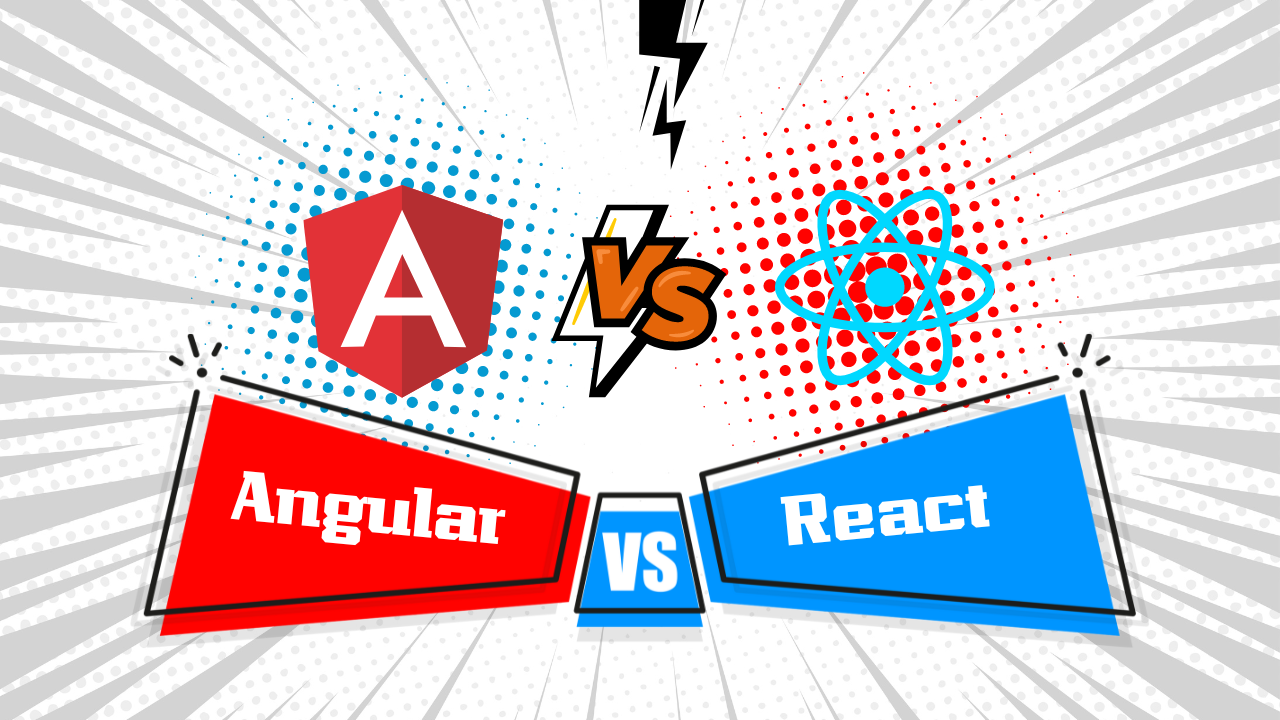
In the ever-evolving landscape of web development, Angular and React stand as two titans competing for supremacy. As 2024 unfolds, developers and businesses alike are keen to determine which of these frameworks of Angular vs React will lead the charge. This article delves into the intricacies of Angular vs React, comparing their features, performance, and community support to help you decide which one is best suited for your projects this year.
Introduction to Angular and React
What is Angular?
Angular, is a comprehensive front-end framework maintained by Google. It provides a full-fledged solution for building dynamic web applications, offering features such as two-way data binding, dependency injection, and a robust template syntax. Angular is known for its opinionated architecture, which helps enforce best practices and a structured approach to development.
What is React?
React on the other hand, is an open-source JavaScript package, was created by Facebook and is used mostly for single-page applications when creating user interfaces. By enabling the creation of reusable user interface components, it improves the effectiveness and maintainability of the development process. React’s core philosophy is to provide a declarative approach to UI development, enabling developers to design views for each state in their application.
History and Evolution
Angular’s Journey
Angular has undergone significant transformations since its inception in 2010. Initially released as AngularJS, it was a groundbreaking framework that introduced many concepts now standard in modern web development. In 2016, Google released Angular 2, a complete rewrite of the framework, addressing many of the limitations of AngularJS. Since then, Angular has continued to evolve, with regular updates bringing new features and improvements.
The Rise of React
React was introduced in 2013, and its component-based architecture quickly gained traction among developers. Its virtual DOM, which efficiently updates and renders only the components that change, revolutionized the way developers approached front-end development. Over the years, React has grown to become the go-to library for many large-scale applications, with a thriving ecosystem of marketing tools for ecommerce and libraries.
Core Features Comparison
Component Architecture
Angular: Angular also adopts a component-based architecture but with a more structured and opinionated approach. Components in Angular are tightly integrated with services and directives, providing a comprehensive solution for building complex applications.
React: React’s component-based architecture allows developers to build encapsulated components that manage their own state. This modularity makes it easy to reuse and compose components, leading to more maintainable and scalable codebases.
Performance
Angular: Angular uses a real DOM, which can sometimes lead to performance bottlenecks in large applications. However, Angular’s change detection and optimization techniques help mitigate these issues, ensuring reasonable performance for most use cases.
React: React’s performance is largely attributed to its virtual DOM. By minimizing direct manipulation of the actual DOM, React ensures efficient updates and rendering, leading to a smoother user experience.
Learning Curve
Angular: The comprehensive nature of Angular results in a steeper learning curve. It requires understanding concepts like dependency injection, decorators, and RxJS. However, once mastered, Angular’s powerful features can significantly enhance productivity.
React: The learning curve for React is not too steep, especially for those who are already proficient with JavaScript. Its focus on a single responsibility (UI rendering) makes it easier to grasp and integrate with other libraries.
Development Experience
Tooling and Ecosystem
Angular: Angular provides an all-in-one solution with its CLI (Command Line Interface), which simplifies project setup, scaffolding, and deployment. The Angular ecosystem is also robust, with a wealth of official and community-maintained libraries.
React: React boasts a rich ecosystem with a plethora of tools, libraries, and extensions. From state management solutions like Redux to build tools like Create React App, developers have access to a wide range of resources to streamline development.
Flexibility and Customization
Angular: Angular’s opinionated structure means many decisions are made for you, providing a clear path for development. While this can limit flexibility, it ensures consistency and adherence to best practices across projects.
React: React’s unopinionated nature allows developers to choose their own tools and libraries for routing, state management, and other functionalities. This flexibility is a double-edged sword, offering freedom but also requiring careful decision-making.
Community and Support
Popularity and Adoption
Angular: Angular also enjoys a strong community, backed by Google’s support. While it may not be as widely adopted as React, it is favored by many large organizations for its robustness and enterprise-ready features.
React: React has a massive following, with a vibrant community contributing to its growth. It is widely adopted in both startups and established enterprises, making it a popular choice for new projects.
Documentation and Resources
Angular: Angular’s documentation is equally extensive, with detailed guides and examples. The Angular community also provides numerous resources, including video tutorials, blog posts, best shopify themes and online courses.
React: React’s documentation is comprehensive and user-friendly, making it easy for developers to get started. Additionally, there is a wealth of tutorials, courses, and community forums available for learning and troubleshooting.
Use Cases and Real-World Applications
When to Choose Angular
Angular is well-suited for large-scale enterprise applications that require a robust framework with comprehensive features. Its opinionated structure and built-in tools make it an excellent choice for projects with complex requirements and multiple developers. Notable examples of Angular applications include Google Cloud Platform, Microsoft Office 365, and Upwork.
When to Choose React
React is ideal for projects where flexibility and performance are paramount. Its component-based architecture makes it perfect for single-page applications (SPAs), interactive user interfaces, and projects that require frequent updates and dynamic content. Companies like Facebook, Instagram, and Airbnb have successfully leveraged React to build their user interfaces.
Future Prospects
Angular in 2024
As we move into 2024, Angular’s future looks equally promising, with a focus on enhancing developer productivity and application performance. Upcoming releases aim to streamline development workflows, improve tooling, and introduce new features that address modern web development challenges. Google’s commitment to Angular ensures its continued evolution and adoption.
React in 2024
React continues to evolve with new features and improvements. The introduction of React Server Components and Concurrent Mode promises to enhance performance and developer experience. React’s active community and ongoing support from Facebook ensure its relevance and growth in the coming years.
Conclusion
In the battle of Angular vs React, there is no definitive winner. Both frameworks have their strengths and are suited for different types of projects. Angular’s comprehensive features and structured approach are perfect for large-scale enterprise solutions, while React’s flexibility and performance make it ideal for dynamic and interactive applications.
Ultimately, the choice between Angular vs React depends on your specific project requirements, team expertise, and long-term goals. By understanding the unique benefits and limitations of each framework, you can make an informed decision that aligns with your development needs in 2024 and beyond.
Whether you choose Angular or React, both frameworks offer powerful tools to build modern, responsive, and scalable web applications. Happy coding!